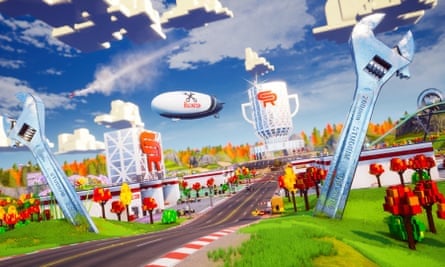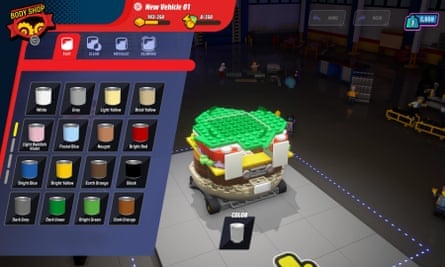C.Classic video games never really die. While designers and producers still remember them, their influence lives on and they can pop up in the most unexpected places. 2K Games has announced a new deal with Lego, which will start with Lego 2K Drive, an open-world racing game created by veteran studio Visual Concepts. It combines the explorable world and recognizable challenges of Forza Horizon with the fun driving, weapons, and power-ups of Mario Kart, but its origins lie in an entirely different set of car games.
Executive producer Mark Pierce began his gaming career at Atari in the late 1980s, working on the company’s classic racing games RoadBlasters, Road Riot, and San Francisco Rush, and was around as another team created the legendary racing simulator. 3D Hard Drivin’ racing. “I was very lucky because a lot of the original Atari guys were still there,” he recalls. “David Sheppard, who was the second software engineer hired, and Peter Takaichi’s group, who did all the mechanical design. I met Jed Margolin, one of the guys who invented forced feedback steering. It was amazing, the culture was so strong, so creative… Many of us at Visual Concepts South have a legacy of creating arcade racing games. We really wanted to make an arcade-style game that was easy to pick up, but hard to master.”
Pierce’s ambition has been to bring Atari’s arcade design mindset of the 1980s to modern open-world racing game design. Players drive through the delicious and colorful world of Bricklandia, unlocking races, tasks, and missions. There are Lego towns packed with colorful shops and restaurants, Lego canyons, and Lego farms (full of cute Lego pigs). You can run through gothic castles populated by ghosts and giant spiders. Wherever you go, minifigures roam, often with little challenges for you. Playing an early demo of the game, I found myself leaping over rocky chasms, chasing down and retrieving lost characters, and running over robot invasion forces. Story mode has many cutscenes that capture the typical wacky humor of Lego movies and games.

The Atari influence can be felt most deeply in the super-accessible handling model. There’s a heavy emphasis on drifting: tap the brake going into a corner and your rear end will slide easily, allowing you to glide across acres of asphalt, controlling the angle with the analog stick. There are three different surfaces to drive on (street, off-road, and water) and cleverly your ride instantly transforms into the appropriate vehicle as soon as you need it: jump off a ramp into a river and your truck suddenly turns into a speedboat. quick. . This frictionless fun extends to collisions: most objects you hit, from fences to trees, explode into Lego blocks on impact without hindering your progress. In fact, breaking things helps repair your own vehicle, so just like in the Lego Star Wars games, breaking things is strongly encouraged.
The fluidity and verticality of the game, where realism is easily eschewed in favor of stunts and thrills, really reminded me of Midway’s underrated arcade racing games of the ’90s, like the Cruis’n series and Hydro Thunder. Turns out it’s not a coincidence. “We have Brian Silva and Steve Ranck at Visual Concepts; they both worked at Hydro Thunder,” explains Mark. “We all know that there is a real skill, a real nuance, to understanding how to do something fun, how to make sure cars can go up walls without a problem, how to make it fun to crash into things. It’s buttery, you just go through the stuff… [tuning racing games is] a long and iterative process, it is a kind of craft.”
All over the world there are stores where you can buy new clothes and personalized items for your vehicle and driver. The game also has an in-depth build mode where you can build your own vehicles from scratch using around a thousand different Lego bricks as well as stickers. You’ll also apparently be able to mod vehicles out of the box, and while 2K wouldn’t confirm it, it’s likely that creators will be able to share their custom designs with other players.

As far as power-ups go, we’re definitely in Mario Kart territory. During races, you can choose quest missions, speed boosts, and a cloaking device, as well as spider webs that act like Mario Kart’s inkblots, obscuring the screen for other drivers. The tournament structure is familiar too, a series of cup events where races are ranked by level of difficulty. 2K promises competitive six-player online racing, but there’s also split-screen for cooperative and competitive local multiplayer.
after newsletter promotion
It’s been 20 years since American developer High Voltage Software released Lego Racers, a driving simulator that combined the spectacular gameplay of Mario Kart with the visual style and building possibilities of Lego. A sequel followed a couple of years later, but somehow the compelling idea of a build-yourself Lego racing game fell by the wayside when Traveller’s Tales bombarded the market with its excellent Lego movie tie-ins. Now it’s back, and it’s nice to see that in such a big, brand new family game, the legacy of some of the great arcade games of the ’80s and ’90s lives on.
 NEWSLETTER
NEWSLETTER





